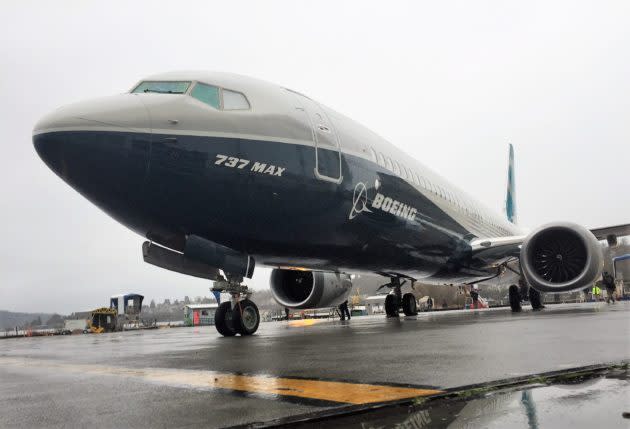Boeing says problem with 737 MAX warning signal slipped through the cracks

Boeing says a warning alert system that figures in the investigation of two catastrophic 737 MAX crashes didn’t work the way it was supposed to because of a software flaw that engineers identified a year before the accidents.
The revelation adds a new twist to the debate over the company’s safety practices.
In this case, the debate focuses on a feature known as the “AOA Disagree” alert, which is supposed to light up in the cockpit if there’s a mismatch in data coming from two angle-of-attack sensors on the plane. Investigators suggest that bad sensor data played a key role in October’s Lion Air crash in Indonesia, which killed all 189 people aboard the plane; and March’s Ethiopian Airlines crash, which killed 157.
Within days of the Ethiopian crash, all 737 MAX airplanes were grounded worldwide.
Boeing engineers knew about a problem with the “AOA Disagree” alert well before that. The alert was originally intended to be a standard feature on the 737 MAX and the previous generation of 737 planes, known as the 737 NG (for “Next Generation”). But in a statement issued on Sunday, Boeing said that in 2017, several months after deliveries began, engineers became aware that the 737 MAX display system software didn’t meet the original requirements.
“The software delivered to Boeing linked the AOA Disagree alert to the AOA indicator, which is an optional feature on the MAX and the NG. Accordingly, the software activated the AOA Disagree alert only if an airline opted for the AOA indicator,” Boeing said.
The company said it followed standard procedure for reviewing the issue, and determined that neither the software-based angle-of-attack indicator nor the alert was necessary for safe operation of the airplane.
“Accordingly, the review concluded, the existing functionality was acceptable until the alert and the indicator could be delinked in the next planned display system software update,” Boeing said. “Senior company leadership was not involved in the review and first became aware of this issue in the aftermath of the Lion Air accident.”
That’s also when Boeing discussed the issue with the Federal Aviation Administration. About a week after the Indonesia crash, Boeing and the FAA issued bulletins noting that both the angle-of-attack indicator and the alert system were optional.
Last December, Boeing conducted a follow-up internal safety review, which confirmed the view that the absence of a warning alert did not present a safety issue. The findings of that review were shared with the FAA, Boeing said. Three months after the review, the Ethiopian crash occurred.
In the wake of that crash, Boeing has said the “AOA Disagree” issue will be fixed before the 737 MAX returns to flight.
“Boeing is issuing a display system software update, to implement the AOA Disagree alert as a standard, standalone feature before the MAX returns to service,” the company said in its statement. “When the MAX returns to service, all MAX production aircraft will have an activated and operable AOA Disagree alert and an optional angle of attack indicator. All customers with previously delivered MAX airplanes will have the ability to activate the AOA Disagree alert.”
Sunday’s statement adds context to earlier reports that the angle-of-attack alert system was available only as part of an optional software package.
It’s debatable whether either of the crashes could have been avoided if the alert was available as a standard feature on the planes involved. In the Ethiopian case, the investigation suggests that the pilots knew about the issue surrounding the angle-of-attack sensors and their effect on the 737 MAX’s automatic flight control system — but were nevertheless unable to pull the plane out of its final dive.
In any case, the questions surrounding what Boeing engineers knew and when they knew it seem sure to figure in the multiple investigations sparked by the crashes.
U.S. Rep. Rick Larsen, D-Wash., told KOMO News that the FAA’s actions before and after the crashes will also be examined during a May 15 hearing before the House Subcommittee on Aviation, which he chairs.
”We need to first find answers to ensure the safety of the airplane, to ensure the FAA is doing the right thing, that Boeing is doing the right thing, and that’ll be our focus,” Larsen told KOMO on Saturday, a day before Boeing issued its statement.
In a posting to Leeham News, aviation expert Scott Hamilton said that it could take weeks or even months longer to recertify the 737 MAX for flight, and that the planes aren’t likely to return to service until July or August.
More from GeekWire:
Report: Optional safety features for Boeing 737 MAX jets will be offered for free
Boeing CEO rebuffs the idea of resigning amid debate over 737 MAX’s fitness to fly
Regulators ground Boeing 737 MAX jets in Europe despite reassurances from FAA
In wake of 737 MAX crash, Boeing issues bulletin to address erroneous sensor input
